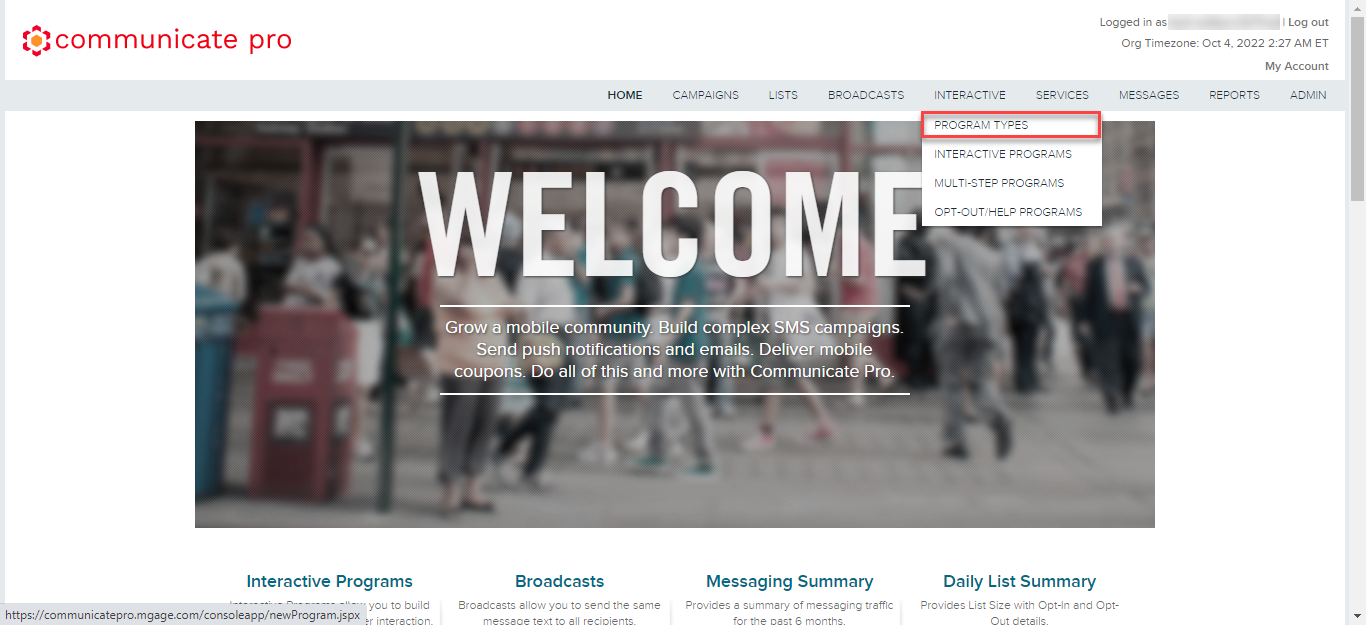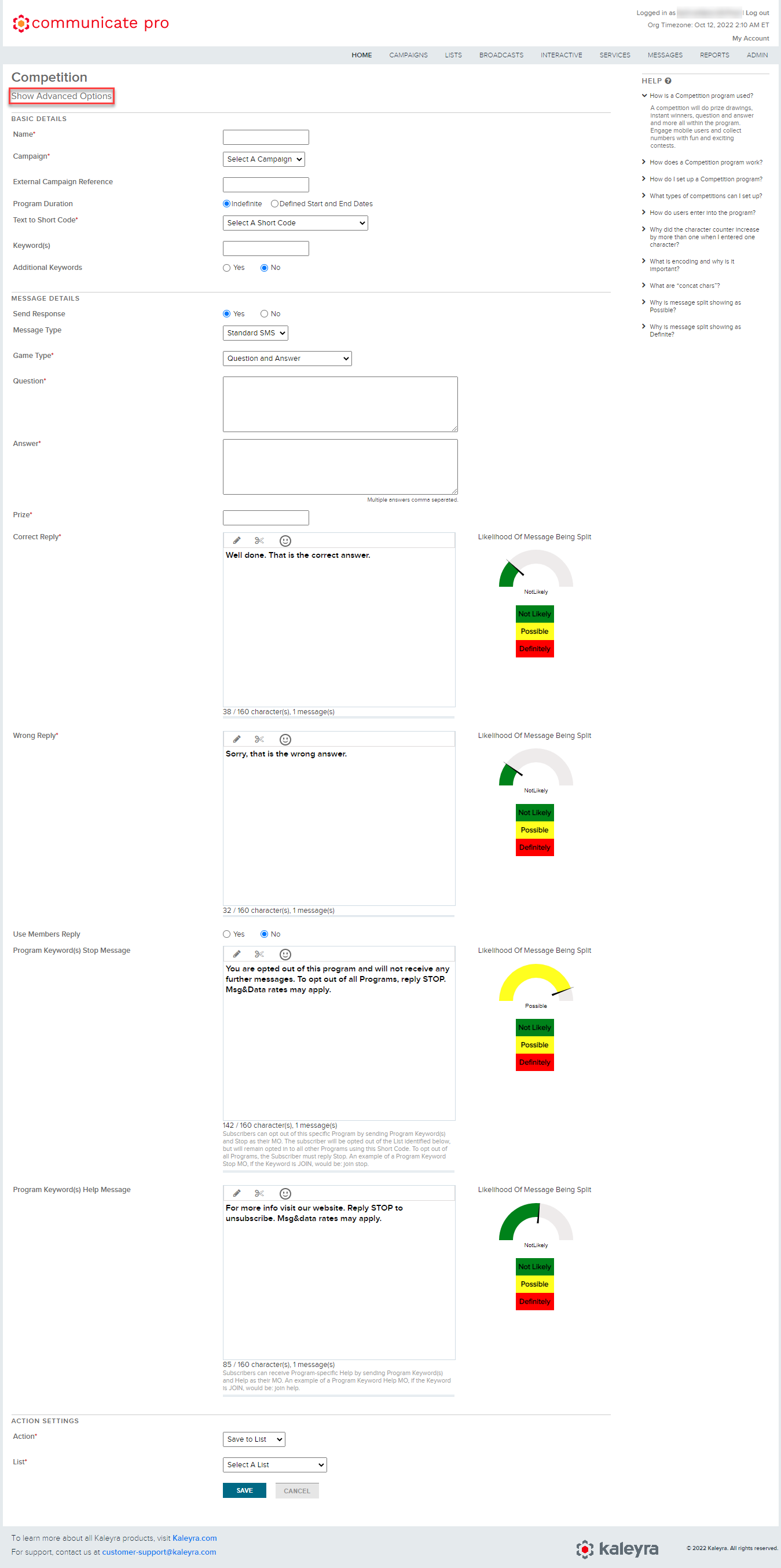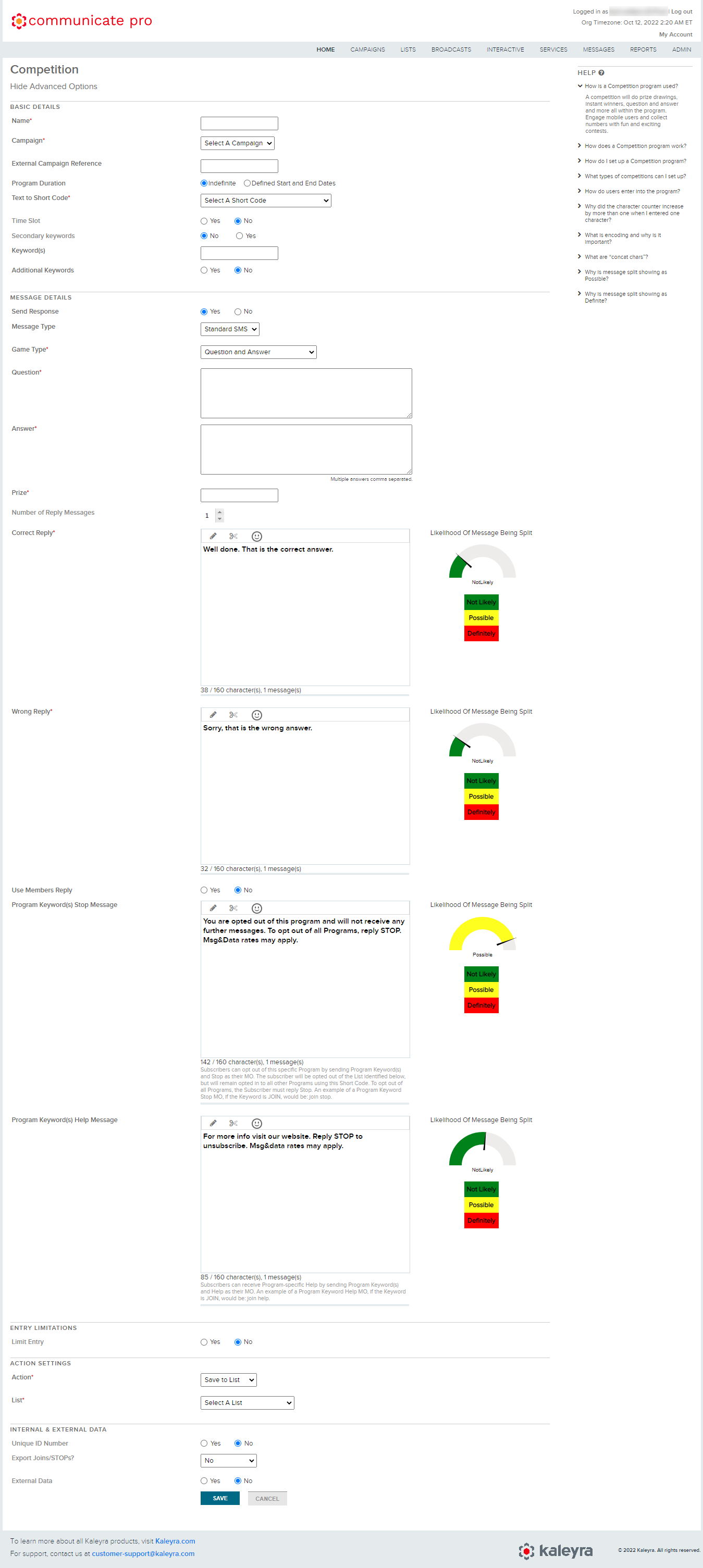Competition
The competition template offers the ability to specify right and wrong responses, winning messages, and perform the winner selection at the end of the competition.
There are following three types of competitions:
- Question and Answer
- Prize Draw
- Instant Winner
How does the competition work?
Your mobile users will send text messages from their phones containing a keyword followed by a space and then their answers to a short code. This is delivered to Communicate Pro, which returns either a Correct Reply or a Wrong Reply depending on what is defined as the correct answer.
Consider an example of Competition for radio stations. The radio station asks a question over the air and a subscriber will send the keyword + their answer to the short code for the Question/Answer type. Or the station says "send (keyword) to (short code) for your chance to win" for the prize draw and instant winner types.
To set up a competition, perform the following steps:
- Log in to the Communicate Pro account.
The communicate pro home page appears.

- From the top menu bar, hover over INTERACTIVE, and then select PROGRAM TYPES.
The Interactive Programs page appears.

- Click Competition.
The Competition page appears.

- Click Show Advanced Options to view advanced options.
The advanced options field appears.

-
In the BASIC DETAILS section, perform the following steps:
- In the Name field, enter a name for the competition.
- Click the arrow next to the Campaigns field, a list of options appears, select a campaign.
- (Optional) In the External Campaign Reference field, enter the external campaign reference.
- (Optional) The duration enables your messengers during which they can interact with the program. From the Program Duration option, select any one of the following:
- (Default) Indefinite - To keep the text response active for an indefinite time.
- Defined Start and End Dates - The start and end time are important to competitions as they defines the window during which entries will be accepted. After the end time, the winner pool will be considered complete and the winner selection feature will become available. In the Start Time & Date fields, enter the time and start date. In the End Time & Date fields, enter the time and end date.
- Click the arrow next to the Text to Short Code field, and a list of options appears, select a short code that you will use to communicate with your subscribers. You can be charged for a separate short code, verify your short code before selecting it.
- From the Time Slot option, select one of the following:
- Yes - If you select Yes, then you have to define the program duration (when entries will be accepted until). It is highly recommended to define a program duration to mitigate unwanted noise and to use the program as it was intended. To define the time interval when the competition is in the active stage. Enter the time from and to with the correct format when the competition will be active.
- (Default) No - If you select No then the program will continue to accept entries for an unlimited duration. The best case is if the brand will do random drawings until all prizes have run out (that is, the brand does not know how long it will take to run out of prizes).
- Secondary keywords is only visible using the Advanced Options. It allows you to leverage if an answer is close but not exactly correct, and maybe you still want to accept it into the program. Or maybe they base 1st and 2nd place of this option. From the Secondary keywords option, the default is No, select Yes, if you want to add a secondary keyword for the competition. The secondary keywords provide you with an option to use them as the secondary keywords for the competitions.
- Keyword(s) triggers the program. The subscribers would send the identified keyword to be entered into the program. In the Keyword(s) field, enter the keywords that will help you in sending the short code to your user based on these keywords. Based on your selection of Secondary keywords, an additional field is available for secondary keywords.
- You can have different/several keywords that trigger the same program. You may want 'Blue' as a keyword for those subscribers who heard the competition on the radio, and they want the keyword 'Gray' as a keyword for those subscribers who saw the competition on the radio station's social media page. They can leverage the program to differentiate their subscriber base. Multiple keywords to one program are less common, but it can happen. If you want to add additional keywords for a text response, from the Additional Keywords option, select Yes, and enter the keywords in the box that will help you in sending the short code to your user based on these keywords.
-
In the MESSAGE DETAILS section, perform the following steps:
- You can decide whether or not to send a response to the subscriber when they trigger the program. For example, if someone messages 'Blue' to 83034 because they heard it on the radio they can enter for a chance to win $1,000. The radio station doesn't have to respond. However, most will send an MT back saying 'Thanks for entering'. This is the response that would get sent to a Brand's 'mobile users' or subscribers. From the Send Response option, select one of the following options:
- (Default) Yes - To opt-in to the response from your messengers.
- No - To opt out of the response from your messengers.
- Click the arrow next to the Message Type field, list of options appears, select one of the following options:
- Standard SMS - Consistent and use 'Mobile Users' and 'Subscribers' where applicable. Mobile users for temporary interactions versus Subscribers for mobile users who are added/subscribe to a list for an extended period of time. This allows your messenger to send standard SMS.
- MMS - This allows your messenger to send MMS.
- Click the arrow next to the Game Type field, list of options appears, select one of the following options:
- Question and Answer - Enter the question that the mobile users will be asked. It will not be sent as a separate message to mobile users but rather placed in the Call to Action (CTA) with the short code and keyword. The CTA is triggered by a Mobile User sending the correct keyword + any additional requirements to the Brand's specified short code. For example, the radio host might say 'Send Pickle to 83034 and that is therefore the CTA. Or maybe they have a tagline that says that same info on their social media, then that would be the CTA. Specify the correct answer to the question, which will be used as validation against the text string following the keyword in each MO. Enter the number of winners, whether recurring winners are allowed, and the prize. The correct reply is the response that will go out to all mobile users that provided the correct answer and the wrong reply will be sent to mobile users that provided the incorrect answer. In the Question field, enter the question, and in the Answer field, enter the correct answer.
- Question and Answer (keywords) - In the Question field, enter the question, and in the Answer field, enter the answer with keywords.
- Prize Draw - The prize draw competition type accepts all entries to the program and enters them into the drawing. The Prize Draw reply will be the confirmation message that mobile users receive when they have been entered into the drawing. The additional reply will go out to mobile users at the end of the program when the entry window is closed. Prize draw works based on keywords. You have the option to setup either way.
- Prize Draw (multiple replies) - Prize draw based on keywords with an option of multiple replies. One mobile user to send in Multiple MO's.
- Instant Winner - The instant winner game type uses a question and answer format in which correct answers have a chance to win instantly (The Brand decides what they are providing as a prize to the mobile user(s). There is a free form field in ComPro. The field can be used as a dynamic property, that is external facing) rather than a prize drawing at the end of the competition. The question will be part of the call to action. The answer will be the word or text string following the keyword. For instant competition. In the Question field, enter the question, and in the Answer field, enter the answer.
Notes:
- To draw winners for the prize draw and question and answer competition types (the main difference is Q&A collects answers whereas Prize Draw collects entries), go to the program from the Interactive > Interactive Programs page. The program must have ended before the winner drawing can be done. Click the name of the Competition program from the table to view the details.
- Once on the details page, click the View Winners button to make winner selections.
- Indicate the number of winners and the winning message for each tier (This feature is activated only when the program is completed (either manually or upon duration completion). It will be available on the Program Details page) and leave blank any that are not applicable. To manage the winners for each prize tier, select an existing list or create a new list to which they will be saved.
- The losing message is another option field to manage entries that did not win, save them to a list, and send them a message if desired. Both winning and losing lists may be referenced in future programs.
- Finally, indicate whether each mobile user will be limited to one entry and then click Perform Draw.
- You can decide whether or not to send a response to the subscriber when they trigger the program. For example, if someone messages 'Blue' to 83034 because they heard it on the radio they can enter for a chance to win $1,000. The radio station doesn't have to respond. However, most will send an MT back saying 'Thanks for entering'. This is the response that would get sent to a Brand's 'mobile users' or subscribers. From the Send Response option, select one of the following options:
-
In the ENTRY LIMITATIONS section, from Limit Entry, select one of the following options::
- (Default) No - If there is no entry limit for the competition.
- Yes - If you want to limit the participants based on number and duration. Enter the following details:
- In the Entries Allowed field, enter the number of entries accepted for the competition. The entries are for the number of participants.
- The Entry Window allows you to define the duration you want to keep the competition active. The default is Program Duration without any duration. You can select the Defined Length in hours and days to keep the competition active for the defined length.
- The Limit Reached Response allows you to define the message response if your competition has passed the entries allowed counts. The default is No Response if you do not want to send any message response. You can select Send Response, and enter the message you want to send as the limit reached response. You can use Insert dynamic value, URL shortener, and Smiley in your response message.
-
To receive an email for each entry, select Save Entries and Forward to Email and then enter the email address to which they will be sent. The option to save entries and forward a .csv file to an email will send one .csv file at the end of the program with all of the entries for the entire program in the .csv file. These emails may be sent to multiple email addresses by entering them in the emails field separated by commas. Use the finished message to inform late entries that the program has closed. In the ACTION SETTINGS section, perform the following steps:
- In the Actions field, click the Select Action drop-down arrow to view the list, and select the Save to list option To save the text response to a list.
- In the List field, click the arrow next to Select A List to view the list, and select the list you want to map to the text response. You have to provide additional details based on the list you have selected. For example, Broadcast Demo List, Opt-in Demo List, and many more.
-
INTERNAL & EXTERNAL DATA are related to the handling of entries. Specifically an entry (that is, opt-in) to the competition program received via an external source (for example, a web entry). The internal and external data allows you to opt-in and opt-out or join and stop, which can be sent or received externally (if required). In the INTERNAL & EXTERNAL DATA section, perform the following steps:
- From the Unique ID Number, select one of the following options:
- Yes - To send or receive messages with a unique ID number.
- (Default) No - To send or receive messages without a unique ID number.
- In the Export Joins/STOPs? field, click the arrow next to No, the following list appears, select one of them and enter the Method, URL, User Name, Password, and Internal Reference details:
- Stops Only
- Signups Only
- All
- In the External Data field, select one of the following options:
- (Default) No - If you do not want the external data.
- Yes - If you want the external data. You need to provide Method, URL, User Name, Password, External Reference, and Error message.
Note:
To send information select POST, and to retrieve information select GET. Enter the URL to which the request will be sent and the user credentials.
- From the Unique ID Number, select one of the following options:
-
Click Save. The competition is saved.
Updated 6 months ago
